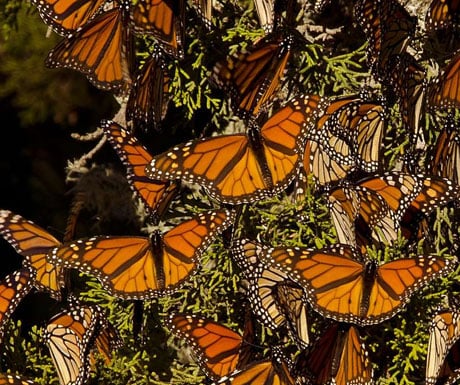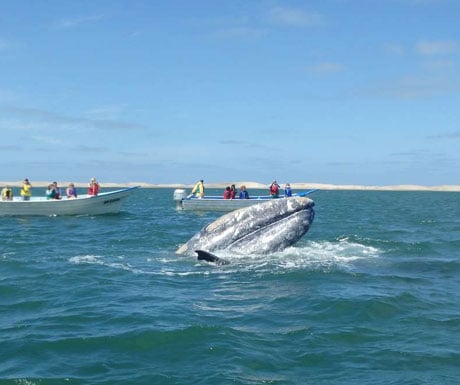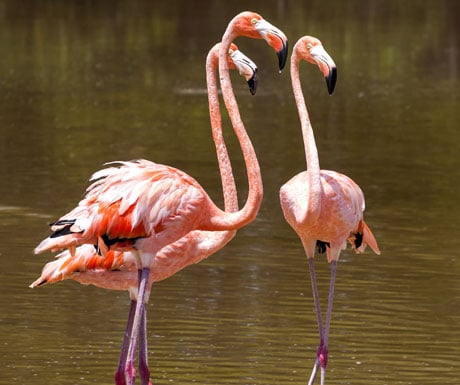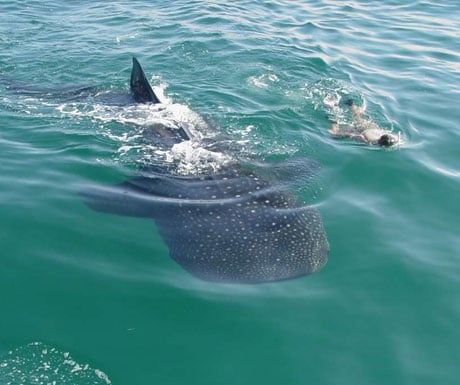The top 5 wildlife phenomena in Mexico
Mexico is a huge and historic country with a diverse range of habitats. The snow-capped mountains, pine-forested highlands, tropical rainforest, dry cactus deserts and rich seas not only offer great a wilderness to explore but an abundance of wildlife spectacles too. Here are our favourite five wildlife experiences when on a holiday in Mexico.
1. Monarch butterfly migration
Between October and March the spectacular Monarch butterfly migration happens in the high altitude forests of Michoacán State. Explore the reserves and observe how the butterflies hang in their thousands from the branches before lifting in vast clouds to return to Canada and the USA.
 2. Grey whales
The grey whales arrive to Baja Californias Coast to calf and nurse their young between November and March. The Sea of Cortes, hailed one of the richest marine reserves in the world, is where to find these incredible gentle giants.
2. Grey whales
The grey whales arrive to Baja Californias Coast to calf and nurse their young between November and March. The Sea of Cortes, hailed one of the richest marine reserves in the world, is where to find these incredible gentle giants.
 3. Fireflies
During the months of June, July and August, the firefly spectacle can be enjoyed in Espolón in the Sierra Nevada in Tlaxcala State. The lower slopes of the Popocatepetl and Iztaccihuatl volcanoes are home to a large population of fireflies that arrive each year to mate. As night falls, the female fireflies signal to the males, lighting up 200 hectares like a magical Christmas scene.
4. Flamingos
There is nothing quite like the wash of pink at Celestún Reserve. It is believed that 90% of the worlds flamingos migrate to the Gulf of Mexico to mate between March and April. Two sites, Celestún and Ría Lagartos, at opposite ends of the Gulf of Mexico, have been awarded Biosphere status as the only mainland breeding sites in North America. Although easily accessible for day trips, staying nearby the sites can allow for wonderful morning viewings when you are most likely to see them in flight. Did you know that flamingo chicks are born white and it is the build-up of carotene in the crustaceans they eat that give them their pink plumage?
3. Fireflies
During the months of June, July and August, the firefly spectacle can be enjoyed in Espolón in the Sierra Nevada in Tlaxcala State. The lower slopes of the Popocatepetl and Iztaccihuatl volcanoes are home to a large population of fireflies that arrive each year to mate. As night falls, the female fireflies signal to the males, lighting up 200 hectares like a magical Christmas scene.
4. Flamingos
There is nothing quite like the wash of pink at Celestún Reserve. It is believed that 90% of the worlds flamingos migrate to the Gulf of Mexico to mate between March and April. Two sites, Celestún and Ría Lagartos, at opposite ends of the Gulf of Mexico, have been awarded Biosphere status as the only mainland breeding sites in North America. Although easily accessible for day trips, staying nearby the sites can allow for wonderful morning viewings when you are most likely to see them in flight. Did you know that flamingo chicks are born white and it is the build-up of carotene in the crustaceans they eat that give them their pink plumage?
 5. Whale sharks
Whale shark season on the Caribbean Coast of Mexico takes place in May to September and is undoubtedly one of the most exciting snorkelling experiences out there. Spend a day on the jewel- like Caribbean Sea swimming with these gentle giants as they surface to feed on plankton. Averaging 30ft in length, it is a truly breath taking experience. Be there for the annual whale shark festival in July.
5. Whale sharks
Whale shark season on the Caribbean Coast of Mexico takes place in May to September and is undoubtedly one of the most exciting snorkelling experiences out there. Spend a day on the jewel- like Caribbean Sea swimming with these gentle giants as they surface to feed on plankton. Averaging 30ft in length, it is a truly breath taking experience. Be there for the annual whale shark festival in July.
 Justin Wateridge is Managing Director at Steppes Travel.
If you would like to be a guest blogger on A Luxury Travel Blog in order to raise your profile, please contact us.
Justin Wateridge is Managing Director at Steppes Travel.
If you would like to be a guest blogger on A Luxury Travel Blog in order to raise your profile, please contact us.
 2. Grey whales
The grey whales arrive to Baja Californias Coast to calf and nurse their young between November and March. The Sea of Cortes, hailed one of the richest marine reserves in the world, is where to find these incredible gentle giants.
2. Grey whales
The grey whales arrive to Baja Californias Coast to calf and nurse their young between November and March. The Sea of Cortes, hailed one of the richest marine reserves in the world, is where to find these incredible gentle giants.
 3. Fireflies
During the months of June, July and August, the firefly spectacle can be enjoyed in Espolón in the Sierra Nevada in Tlaxcala State. The lower slopes of the Popocatepetl and Iztaccihuatl volcanoes are home to a large population of fireflies that arrive each year to mate. As night falls, the female fireflies signal to the males, lighting up 200 hectares like a magical Christmas scene.
4. Flamingos
There is nothing quite like the wash of pink at Celestún Reserve. It is believed that 90% of the worlds flamingos migrate to the Gulf of Mexico to mate between March and April. Two sites, Celestún and Ría Lagartos, at opposite ends of the Gulf of Mexico, have been awarded Biosphere status as the only mainland breeding sites in North America. Although easily accessible for day trips, staying nearby the sites can allow for wonderful morning viewings when you are most likely to see them in flight. Did you know that flamingo chicks are born white and it is the build-up of carotene in the crustaceans they eat that give them their pink plumage?
3. Fireflies
During the months of June, July and August, the firefly spectacle can be enjoyed in Espolón in the Sierra Nevada in Tlaxcala State. The lower slopes of the Popocatepetl and Iztaccihuatl volcanoes are home to a large population of fireflies that arrive each year to mate. As night falls, the female fireflies signal to the males, lighting up 200 hectares like a magical Christmas scene.
4. Flamingos
There is nothing quite like the wash of pink at Celestún Reserve. It is believed that 90% of the worlds flamingos migrate to the Gulf of Mexico to mate between March and April. Two sites, Celestún and Ría Lagartos, at opposite ends of the Gulf of Mexico, have been awarded Biosphere status as the only mainland breeding sites in North America. Although easily accessible for day trips, staying nearby the sites can allow for wonderful morning viewings when you are most likely to see them in flight. Did you know that flamingo chicks are born white and it is the build-up of carotene in the crustaceans they eat that give them their pink plumage?
 5. Whale sharks
Whale shark season on the Caribbean Coast of Mexico takes place in May to September and is undoubtedly one of the most exciting snorkelling experiences out there. Spend a day on the jewel- like Caribbean Sea swimming with these gentle giants as they surface to feed on plankton. Averaging 30ft in length, it is a truly breath taking experience. Be there for the annual whale shark festival in July.
5. Whale sharks
Whale shark season on the Caribbean Coast of Mexico takes place in May to September and is undoubtedly one of the most exciting snorkelling experiences out there. Spend a day on the jewel- like Caribbean Sea swimming with these gentle giants as they surface to feed on plankton. Averaging 30ft in length, it is a truly breath taking experience. Be there for the annual whale shark festival in July.
 Justin Wateridge is Managing Director at Steppes Travel.
If you would like to be a guest blogger on A Luxury Travel Blog in order to raise your profile, please contact us.
Justin Wateridge is Managing Director at Steppes Travel.
If you would like to be a guest blogger on A Luxury Travel Blog in order to raise your profile, please contact us.Did you enjoy this article?
Receive similar content direct to your inbox.


We’ve hiked up to one of the Monarch butterfly sanctuaries near Morelia in the Mexican mountains – amazing to see them!
My family and I are traveling to Baja California Coast & Sea of Cortez in early January. We are really hoping to see some whales while we are there. It would be a first for us all. Thanks again for all the ideas.
Isla Holbox is a great unique island in Mexico to view the whale sharks and pink flamingo’s. Located northwest of Cancun. Beautiful place!
Celestun has much to offer come and visit and enjoy it beaches great seafood its people and its reserve.
I’ve only been to Mexico once and most of the wildlife I saw was at Xcaret, though if you think that’s just a theme park think again. When you have iguanas and giant birds blocking your path you know that this is no ordinary theme park. Just a few weeks later my son went to Isla Holbox and he got some great photos of whale sharks and flamingos. When it comes to Mexico’s wildlife don’t underestimate its diversity.
Here in the U.K. I think that we have a very narrow minded conception of Mexico. For those of us who make it as far as Cancun and then into Yucatan our view of Mexico is largely those Caribbean beaches and those limestone sink holes we swim in.
For those who don’t make it they’ll be astonished by the diversity of both habitat and wildlife. Then, of course, most people forget that Mexico has a coastline on the Pacific Ocean too.